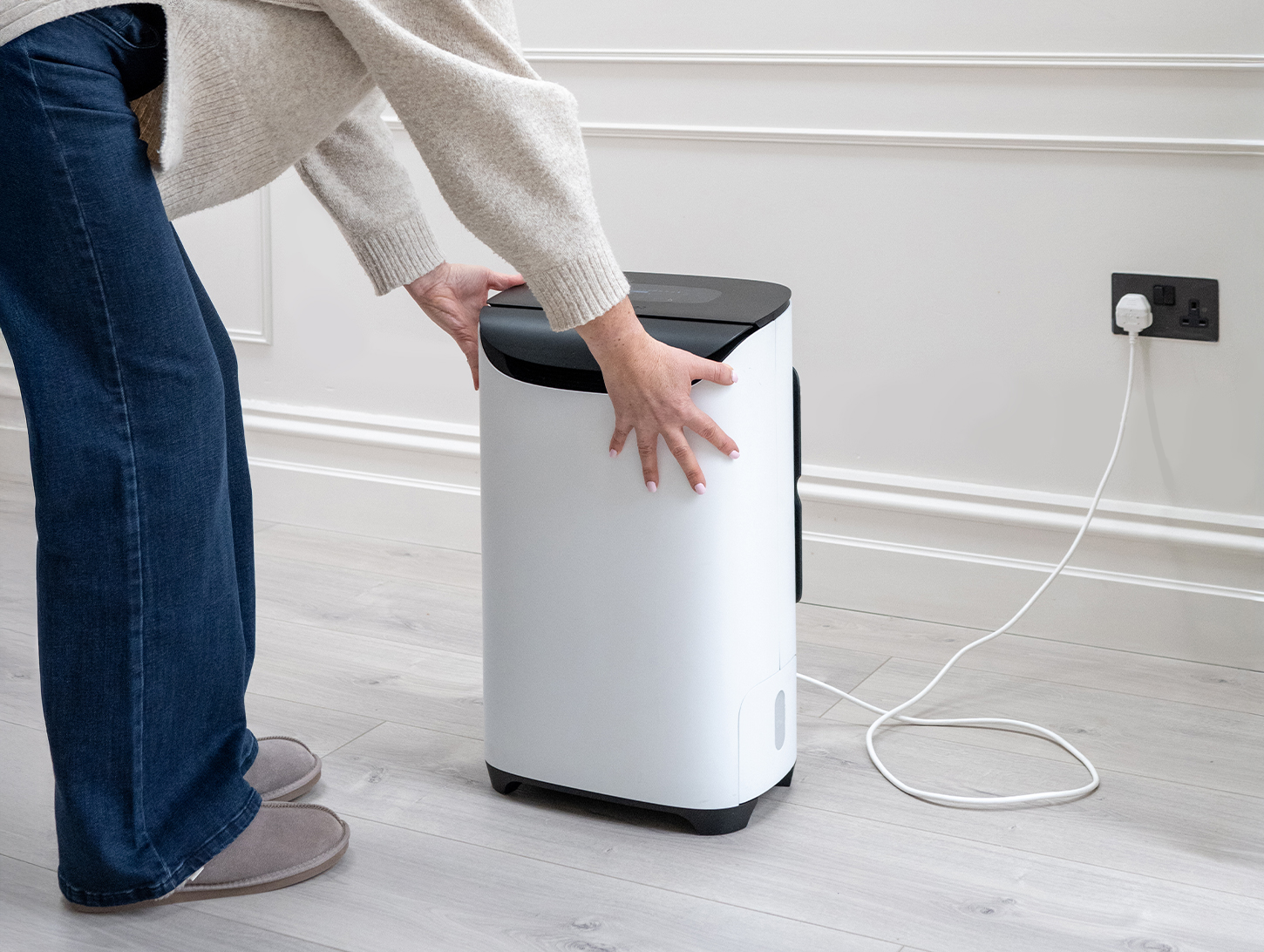As we move into the colder months, the temperature falls, and condensation in our homes rises. Condensation is caused from increased moisture levels, most noticeable as water droplets on windows, which results from the daily routine of showers, baths, boiling kettles, cooking, using a tumble dryer, drying clothes, and even breathing.
Before the days of double glazing, wall and loft insulation, this humid, stale air would find its escape route through ill-fitting windows and doors. It would be replaced by fresher, colder air. But as we hunker down for winter, closing windows and doors, this damp air is captured inside. Condensation means poor air quality and if nothing is improved this can lead to damp or mould which may have a very negative impact on health and the fabric of a home.
Impacts of condensation
- Water droplets can form all over windows and if unlucky, can cause puddles on windowsills

- Condensation can develop on outside walls in extreme cases
- Mould can commonly grow in the bathroom, or on walls or furniture, deteriorating the property and destroying carpets, flooring, wallpaper and furnishings.
- Health can be adversely affected. Mould spores (seeds) spread around a home causing allergic reactions to some when inhaled.
- The energy efficiency of the property is reduced as heating must work harder to try and combat these issues
- Visual deterioration and structural damage to the property
- Moisture becoming entrapped within the structure can result in long term external damage resulting in costly rectification work.
Reducing condensation
To reduce condensation, you must reduce the excess moisture in the property, but simply turning up the heating in the winter will not get rid of condensation. A damp house means damp air, raising the heating thermostat will only heat up the wet air molecules.
Effective ways to combat condensation include:
- Don’t block up any air bricks
- Reduce moisture:
- Put lids on saucepans when you boil or steam vegetables.
- Use an extractor fan when you bathe or shower or open the window for five minutes afterwards.
- Don’t dry washing on radiators, use a clothes horse and put it in a room with an extractor fan.
- If drying clothes in a tumble dryer make sure it vents to outside.
- Warm-up your house:
- Open curtains and blinds during the day to warm rooms up and prevent moisture being trapped around the windows.
- Don’t let furniture touch outside walls: leave a small gap
- Open doors of built-in wardrobes sat against outside walls and try to avoid clothing and shoes from touching outside walls
- Keep gutters clear to make sure water does not spill down your walls

Meaco DD8L Zambezi – ideal for drying clothes indoors - Don’t build patios above the damp course
- Consider buying a dehumidifier. They work by reducing the level of humidity in the air, through sucking in air from the room at one end, removing the moisture, and then blowing it back out into the room again. The Meaco DD8L Zambezi dehumidifier has a Which? Best Buy Award, works well at low temperatures, is cheaper than using a tumble dryer to dry clothes, and as a desiccant dehumidifier, adds warmth back into a room.
A small property will need a small quiet dehumidifier and one that can be moved between rooms. The MeacoDry ABC 10L and 12 range have been designed with flats in mind, with a whisper-quiet noise level of 35dB, low-weight and availability in a choice of colours.
If you have any questions or need any advice about which dehumidifier is best for your requirements, please get in touch. Our team has a wealth of expertise and would be happy to help. Please phone us on 01483 234900 or email: sales@meaco.com
Products featured: Meaco DD8L Zambezi , MeacoDry ABC 10L and 12L








21 responses
Hello Chris just purchased DD8L junior, only ordered on Sunday night and received it Tues morning!!!
We are a family of 2 with a dog, living in a 3 bed detached bungalow with a lean to conservatory along the longest side and a small utility room .The cons gets alot of condensation and the utility room has mould now, even though I dont use it for drying washing. the 2 rooms are on opposite sides of the house.
How should I uses the Junior? should I leave it in the hall, on what setting? or should I move it room to room to get rid of alot of the moisture first. But then will it soon come back when I put it in another room The humidity is reading 78% in the utility Thanks Christine
Christine
Thank you for your purchase and your question. With the rooms being at opposite ends of the house, and maybe with closed doors between them (?), dealing with the damp problems from one location might be tough.
I would go room to room to start with and then think about where the moisture is coming from and locate the dehumidifier closer to the root of the problem.
Chris
Hi I am thinking of purchasing a new dehumidifier just wondering what size to get and where is the best place to position it. We have 3 bed house but downstairs is much larger as we had an extension a few years ago. Down stairs is 2 sitting rooms kitchen dinning room utility and a study. Thanks for any advice Amanda
Amanda,
I would position it closer to where you are having a problem, so if you are seeing the problem downstairs then position it downstairs. I would also think about where the moisture is coming from, so if you are drying a lot of washing on a clothes horse then use the dehumidifier to dry the washing so that the moisture does not get a chance to spread around the house.
A Meaco Arete One 12L will be fine if it is a small 3 bedroom house with up to 3 bedrooms, if you have more people, are drying lots of laundry or it is a large house then go for the Meaco Arete One 20L.
Chris
Because of an ongoing mould and condensation problem, In desperation we splashed out on the MeacoDryArete One dehumidifier. I obviously thoroughly bleached and cleaned off the mould before using the dehumidifier. I was a bit dubious because of the rising energy costs but, hey presto, WHAT a difference !. No more condensation and so far, the mould has taken fright at the humidity level and air quality. Although it is kept on day and night, after the first week of working hard it now seems to have calmed down and has quite a lot of rest periods thus saving on the electricity. I can’t believe how much water it collects no wonder the mould was in heaven. I am used to dehumidifiers because that is part of my job at our local museum – this dehumidifier is an absolute winner with me. So easy to use, (it looks after itself), easily understood booklet in English and not foreign diagramatic instructions, and a quick delivery direct from Meaco. This is looking to be one of my best buys.
Please can you advise ( as the instruction booklet is pretty useless !)- what settings do I use for the Meaco 25L Ultra Low Energy Dehumidifier in order to address dampness and mould in en suite bathroom and bedroom? I have NO idea what setting to use for target ( whatever that means???) and fan speed etc? PLEASE help as this expensive thing is really pretty useless as far as I can see. Many Thanks
Lorna,
Thank you for your purchase. Use Auto mode and that will be fine for your application, the machine will automatically work out the fan speed and target for you.
Chris
I’m delighted with the efficiency of the Meaco Junior. I’ve only been using it for a few days and already the air in my flat is less soggy and the overall environment is more comfortable. Also, it runs quietly. I’m very happy with the product.
I purchased my Meaco 25L Dehumidifier 2 weeks ago and it’s been collecting water, about 4litres daily, no condensation on windows. Now the condensation is back and only collecting a dribble of water 🙁
Susan,
That is because it is so cold outside so despite the fact that the relative humidity on the display of your dehumidifier will be lower than it was when you bought it the windows are a lot, lot colder now so condensation appears. When the air temperature increases the condensation will stop.
Chris
Thanks Chris
It has gone to 47 and turned off then nothing has changed and suddenly goes to 65. I think I have penetrating damp, will this have a negative impact?
Trying to register my purchase, nothing is coming up to input details, can you help me
Joan,
Please use this form to register your warranty – https://www.meaco.com/pages/register-your-warranty
Any problems then please let us know via the Contact Us page on the website.
Chris
I got a 20l low energy dehumidifier at the start of this year. Already it’s taken 60l moisture out of the air and still going. Is this normal?
Lee,
Thank you for your purchase and your question. A dehumidifier will work hard when it is new to a house because it has a lot of catching up to do. It will slow down as the house dries out, this means excess moisture in your walls, furniture, books etc and not just the air. If you have it set to a sensible humidity like 50 or 55%rh then it will switch off when the job is done.
Chris
Just bought a Meaco ABC 10L dehumidifier and wondered why it took us so long to take the plunge!? This is probably the best purchase we have made in many years. Within a couple of days, the improvement in air quality and overall comfort of our property was unbelievable. No more condensation – puddles on window ledges in the morning etc, heating system more efficient etc. We have a 2-bedroomed terrace and this model seems be to be spot-on for our home. Buy with confidence.
Good afternoon
I got a dehumidifier Meaco dry abc 10l and I just would like to make Sure if it is safe to put it in our bedroom as I don’t have any other place to place it so I would like to make sure if I can sleep with it on. My question is because I know this machine has a kind of gas so I don’t know if it is safe.
Thanks for your help
Diana,
Thank you for your purchase and your message. The machine is perfectly safe to have in your bedroom.
Chris